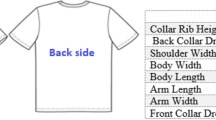Abstract
The effects of two kinds of clothing with different properties with respect to moisture absorption on thermophysiological responses and pulse rate were studied during intermittent exercise at an ambient temperature (T a) of 24°C. The two kinds of clothing ensemble tested were cotton T-shirt with short sleeves and cotton long-sleeved working dress with full-length trousers (C), and polyester T-shirt with short sleeves and polyester long-sleeved working dress with full-length trousers (P), the thermal resistances of which were nearly equal. Five women aged 21–32 years, served as subjects. The environmental conditions were 24°CT a, 50% relative humidity and 0.14m·s−1 air velocity. The subjects, wearing either C or P, exercised for 10-min on a cycle ergometer at an intensity of 30% maximal oxygen uptake and then 10-min rest. This sequence was repeated four times. Rectal and skin temperatures at several sites, local sweating rate, pulse rate and clothing microclimates were continuously compared between C and P throughout the experiment. The major findings were firstly, rectal temperature rose significantly higher in P; secondly, pulse rate was higher in P both during exercise and rest; thirdly, clothing surface temperature on the back rose highly significantly during the fourth exercise period and then fell significantly during the fourth rest period in C; and fourthly, four out of five subjects felt wetter in P during the latter half of the experiment. These results are discussed from the viewpoint that the reduced thermal insulation due to the absorption of moisture in C accelerated dry heat loss, resulting in an inhibition of the increases in core temperature and pulse rate.
Similar content being viewed by others
References
Fujimoto S, Watanabe T, Sakamoto A, Yukawa K, Morimoto K (1968) Studies on the physical surface area of Japanese. 18. Calculation formulas in three stages over all age (in Japanese). Jpn J Hyg 23:443–450
Galbraith RL, Werden JE, Fahnestock MK, Price B (1962) Comfort of subjects clothed in cotton, water repellent cotton and orlon suits. Text Res J 32:236–242
Ha M, Yamashita Y, Tokura H (1995) Effects of two kinds of clothing with hydrophobic and hydrophilic fabrics on local sweating rates at an ambient temperature of 37°C. Ergonomics (in press)
Hardy JD, DuBois EF (1938) The technic of measuring radiation and convection. J Nutrit 15:461–475
Holmér I (1985) Heat exchange and thermal insulation compared in woollen and nylon garments during wear trials. Text Res J 55:511–518
Kamon E, Belding HS (1971) Heart rate and rectal temperature relationships during work in hot humid environments. J Appl Physiol 31:472–477
Nadel ER, Bullard RW, Stolwijk JAJ (1971) Importance of skin temperature in the regulation of sweating. J Appl Physiol 31:80–87
Nielsen R, Endrusick TL (1988) The role of textile materials in clothing on thermoregulatory responses to intermittent exercise. In: Aghazadeh F (ed) Trends in ergonomics human factor V. Elsevier, North-Holland, Amsterdam, pp 449–456
Nielsen R, Endrusick TL (1990) Thermoregulatory responses to intermittent exercise are influenced by knit structure of underwear. Eur J Appl Physiol 60:15–25
Vokac Z, Køpke V, Kebl P (1976) Physiological responses and thermal, humidity, and comfort sensations in wear trials with cotton and polypropylene vests. Text Res J 46:30–38
Wang JH, Yasuda H (1991) Dynamic water vapor and heat transport through layered fabrics. Effect of surface modification. Text Res J 61:10–20
Author information
Authors and Affiliations
Rights and permissions
About this article
Cite this article
Ha, M., Yamashita, Y. & Tokura, H. Effects of moisture absorption by clothing on thermal responses during intermittent exercise at 24°C. Europ. J. Appl. Physiol. 71, 266–271 (1995). https://doi.org/10.1007/BF00854989
Accepted:
Issue Date:
DOI: https://doi.org/10.1007/BF00854989



